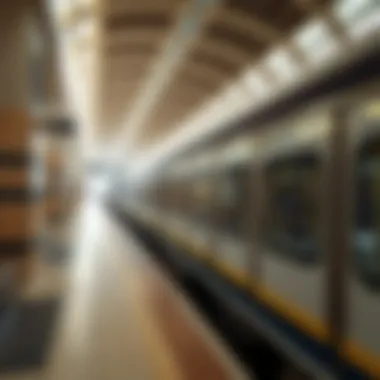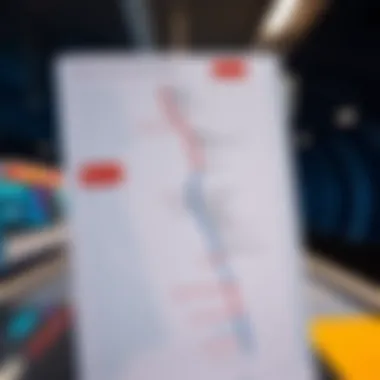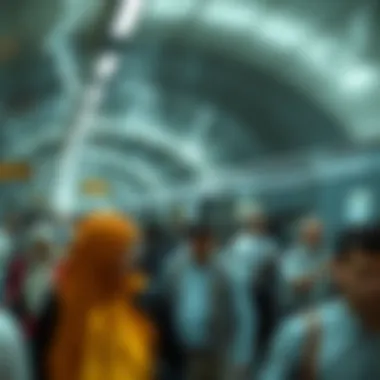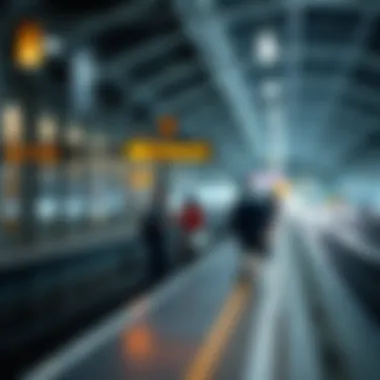Operating Hours of the Dubai Metro: Key Insights


Intro
Navigating the urban landscape of Dubai isn’t solely reliant on grand skyscrapers and luxurious malls. A crucial thread weaving through this city fabric is the Dubai Metro, a lifeline for both its residents and the throngs of tourists that wander its gleaming streets. Understanding the operating hours of this remarkable transit system presents more than just time schedules; it opens a door into the very dynamics of urban mobility, economic trends, and real estate developments.
As Dubai continues to evolve, so do the patterns of transportation and commuting. Busy professionals, hopeful investors, and eager tourists all have their own unique needs when it comes to travel here. The Metro operates not just as a means of getting from point A to point B but as a barometer for larger societal currents—this article seeks to unpack those interconnections.
Stay tuned as we explore how the operating hours of the Dubai Metro affect daily commuters, special events, and the broader context of Dubai’s booming real estate market. A thorough examination of these elements creates a more cohesive understanding of life in this vibrant metropolis.
Understanding the Dubai Metro System
The Dubai Metro is not just a transport mechanism; it symbolizes the city's rapid growth and modernity. As a key element in Dubai's public transportation framework, it offers insights into the broader urban mobility challenges and solutions the city faces. Understanding the Dubai Metro system involves looking at its structure, operations, and the significance it holds for daily commuters and tourists alike.
By analyzing the operating hours, one recognizes how they impact the flow of people throughout the day, contributing to a more fluid urban experience. Particularly for investors, agents, developers, and homeowners, these operational details are not mere numbers — they reflect a living, dynamic ecosystem that influences property values and urban planning.
Overview of the Metro Network
Dubai Metro consists of two main lines — the Red Line and the Green Line, spanning approximately 75 kilometers and connecting many of Dubai's key areas. Unlike many metro systems around the world, much of it runs on elevated tracks, offering passengers panoramic views of the ever-changing skyline.
The stations are strategically placed to enhance accessibility to residential areas, tourist attractions, and commercial districts. This network has been crucial in easing traffic congestion and reducing the reliance on private vehicles, fostering a culture inclined towards public transportation.
Importance of Public Transportation in Dubai
Public transport is fundamental to Dubai, given its status as a global city with a rapidly growing population. The metro system plays a pivotal role in the day-to-day lives of over 400,000 passengers who utilize it daily. Here are a few important aspects to consider:
- Environmental Impact: By promoting the usage of the metro, Dubai encourages a reduction in vehicle emissions, contributing to environmental sustainability.
- Cultural Integration: The metro serves as a hub for people from diverse backgrounds, fostering a sense of community.
- Economic Benefits: A robust public transport system attracts tourists and businesses, directly impacting real estate prices and urban development.
In summary, understanding the Dubai Metro system is crucial not only for commuters and tourists but also for those looking to invest or reside in this vibrant city. The operational hours of the Metro, intertwined with how, when, and where people travel, influence a multitude of factors, making it imperative for stakeholders to stay informed.
Regular Operating Hours
Understanding the regular operating hours of the Dubai Metro is essential for anyone navigating the bustling city. These timetables are more than just numbers on a screen; they directly impact daily routines, productivity, and leisure activities for residents and visitors alike. Commuters rely on this service to travel conveniently across various districts, while tourists benefit from a reliable and efficient way to explore Dubai’s iconic landmarks.
Knowing when the Metro operates can allow for better planning, helping one avoid the frenzied rush common during peak hours. Furthermore, the operational schedule complements the rhythm of city life, particularly in a metropolis where every minute counts, making it a vital component of public transportation.
Standard Weekday Schedule
The standard weekday schedule of the Dubai Metro is meticulously designed to align with the demands of a bustling workweek. Generally, trains operate from 5 AM until midnight on weekdays, accommodating early risers and night owls alike.
- Peak Hours: The busiest times tend to be from 7 AM to 9 AM and again from 5 PM to 8 PM. During these hours, trains run more frequently to manage the increased flow of passengers.
- Frequency: On weekdays, you can expect trains every 2-3 minutes during these peak times. Off-peak times have a longer waiting period, usually around 7-10 minutes, which can be critical knowledge for someone planning their day.
By understanding these patterns, commuters can effectively strategize when to embark on their journeys, reducing waiting times and making the overall experience smooth.
Weekend Operations
Contrasting the weekday flow, weekend operations have a distinct schedule that many find advantageous. On Fridays and Saturdays, the Metro runs from 10 AM to 1 AM, while on Sundays, it reverts to the weekday timings of 5 AM to midnight.


Some key points regarding weekend service include:
- Leisure Focus: This revised schedule supports leisure activities, ensuring that late-night outings are feasible. Friday nights, in particular, present a vibrant atmosphere in many areas of Dubai, making the later hours a boon for social interactions.
- Reduced Frequency: While it maintains a good level of service, the train frequency can decrease to every 5-8 minutes depending on the time of day.
These weekend hours invite both locals and tourists to delve into Dubai's dynamism without the constraints of traditional working hours. It becomes a chance to experience the city's vibrant offerings, from shopping deals to cultural events, with ease.
As one can see, understanding these regular operating hours is not merely a matter of convenience; it has substantive implications for commuting patterns, social behaviors, and urban planning.
"The Metro is the backbone of Dubai's public transport, making life easier for residents and tourists all round."
For additional resources and details, visit:
By capitalizing on the in-depth knowledge of these operational frameworks, residents and tourists alike can navigate Dubai's vast urban landscape more effectively.
Special Occasion Timings
Special occasion timings of the Dubai Metro are a crucial aspect to comprehend, especially for those who frequently navigate the city’s intricate transport system. Major holidays, festive seasons, and significant events can drastically impact the metro’s operating hours. Understanding these variations helps commuters and tourists alike to avoid confusion and plan their travels effectively.
Holidays and Festive Seasons
During major holidays, like Eid al-Fitr and Eid al-Adha, the Dubai Metro adapts its schedule to accommodate the surge in passenger numbers. These times often see a marked increase in ridership as families engage in festive activities around the city.
Here are some notable adjustments:
- Extended Hours: Many times, the metro runs longer than usual, allowing people to enjoy late-night festivities without the worry of last-minute transport issues.
- Peak Service Frequency: The time between trains often decreases, enhancing convenience for those attending holiday events and gatherings. This ensures that both residents and visitors can readily find a ride, reducing wait times.
- Altered Ticketing Options: Special packages or promotions sometimes come into play, allowing users to travel affordably during festive days. This can help families manage their costs while maximizing their outings.
Given the festive nature of these periods, it’s wise for commuters to plan ahead. Checking the official website for updates is essential; who would want to miss that family get-together due to an unexpected schedule?
Major Events and Exhibitions
Dubai is well-known for its extravagant events and exhibitions, such as the Dubai Shopping Festival and EXPLORE, which draw in crowds from around the globe. The impact of special metro timings during these events is evident in several ways.
Impact on Commuters
Understanding the operating hours of the Dubai Metro offers significant insights into how daily commuters experience urban mobility. The reliability and convenience of the Metro can greatly influence both work-life balance and overall lifestyle in a sprawling city like Dubai. These operating hours dictate when and how efficiently people can navigate the city, impacting everything from punctuality to leisure activities.
Effects on Daily Routines
For many commuters, the Metro serves as a lifeline, particularly during the usual workweek. The timing of the trains can shape daily schedules significantly. For instance, catching an early morning train can mean avoiding the stress of traffic jams, ultimately leading to a smoother start to the day. The journey from areas like Al Qusais or Jumeirah to business hubs such as the Dubai International Financial Centre (DIFC) becomes a breeze. However, if the hours restrict service availability, it could spell trouble for those needing to work flexible hours or commute during off-peak times.
- Peak Hours: Morning rush from around 7 AM to 9 AM and evening peaks around 5 PM to 8 PM showcases Metro's influence on commuter flow.
- Night Service: An aspect often overlooked, the operating hours extend late into the night during weekends, offering a respite for night owls. This accommodates not just late-night workers but socialite activities as well.
"The Metro isn’t just about getting from A to B; it’s about how smoothly life flows in between."
Some commuters have even adjusted their work hours to harmonize with the Metro's timetable. In this way, the schedule plays an unspoken role in shaping corporate culture and daily life.


Considerations for Tourists
The Dubai Metro is not only vital for residents but also an essential aspect of the tourist experience in Dubai. Various attractions dotted around the city are conveniently accessible via the Metro, showcasing the system's utility for visitors who may not be familiar with the city. Tourists can traverse from iconic landmarks like the Burj Khalifa to cultural hubs like the Dubai Museum with ease. Therefore, the operating hours are crucial for planning their sightseeing excursions effectively.
- Accessibility: Understanding peak times helps tourists to avoid overcrowding, making their travels smoother.
- Late-Night Adventures: Many attractions remain open late, so aligning Metro schedules with these activities is beneficial.
Furthermore, the convenience of purchasing Metro cards and the availability of multiple languages on signage can enhance the ease of use. The flexible hours provide an essential framework for tourists to experience Dubai without the hindrance of tight schedules.
In summary, the operating hours of the Dubai Metro play an instrumental role in shaping the commuting landscape for both residents and tourists. By considering factors such as daily routines and tourist experiences, it's clear that the Metro is an essential cog in the machinery of Dubai's urban life.
Integration with Other Transport Modes
Understanding how the Dubai Metro integrates with other forms of transportation is pivotal for ensuring efficient urban mobility. The Metro isn’t just a stand-alone system; it serves as a central hub in a larger web of transport options available in the city. This connectivity directly affects commuters' experiences and offers numerous benefits to both residents and tourists.
Connection to Buses and Taxis
The seamless connection between the Dubai Metro and other transport modes like buses and taxis substantially enhances the efficiency of public transport in the city. For instance, major Metro stations like Union and Burjuman are equipped with extensive bus stops, making it uncomplicated for riders to switch from one mode to another. This feature is particularly valuable during peak hours when traffic congestion can make road travel less reliable.
The symbiotic relationship between the Metro and bus services allows passengers to easily reach destinations that are not directly served by the train. Here are some benefits of this integration:
- Wider Coverage: Passengers can journey to outlying neighborhoods or locations beyond Metro reach.
- Time Efficiency: Reducing the time spent waiting for transfers contributes to a more enjoyable travel experience.
- Cost-Effectiveness: This system provides a more affordable option for commuting when combining trips
Apart from bus services, taxis play a crucial role as well. Many commuters prefer hailing a taxi after a Metro ride, especially at the end of long journeys or during late hours. The combination of taxis and the Metro creates a reliable fallback for those needing last-minute transportation.
Walking and Cycling Links
Promoting walking and cycling as complementary modes to Metro travel is a key incentive for Dubai's urban planners. Increasingly, the city has focused on creating pedestrian-friendly zones around Metro stations. This encourages healthier lifestyles and less reliance on cars.
One notable aspect of this integration is the accessibility features that promote walking:
- Pedestrian Bridges: Many stations have dedicated bridges and pathways leading to nearby amenities, several of which also connect to parks or community centers.
- Bicycle Parking Facilities: Designated bike racks and storage areas encourage cycling as a viable transport option, attracting eco-conscious residents and tourists alike.
- Easy Access to Local Attractions: Station placement often aligns with popular destinations, making walking an enticing option for tourists who wish to explore without a vehicle.
In brief, the integration of Dubai Metro with buses, taxis, and options for walking or cycling is instrumental in promoting an efficient, sustainable transport system. This multi-modal approach not only enhances the commuter experience but also contributes positively to urban life in Dubai.
Influence on Real Estate Trends
The relationship between public transport systems and real estate is often a hot topic amongst investors, developers, and homeowners alike. In Dubai, one cannot overlook the significant influence that the metro's operating hours have on real estate trends. The connectivity offered by the Dubai Metro plays a vital role in shaping the city’s property landscape, directly impacting property values, development projects, and lifestyle choices. Understanding this dynamic can be pivotal for anyone looking to make informed decisions in the Dubai property market.
Proximity to Metro Stations
The geographical closeness to metro stations has become a decisive factor for potential homebuyers and renters. Properties within walking distance to a station typically experience higher demand. This is not just about convenience; it's about lifestyle enhancements. When people can easily hop onto a metro, the appeal of living in that area skyrockets.
- Accessibility: Residents value the ability to access various parts of the city seamlessly. Being near a metro station means less reliance on personal cars, which can be a financial burden due to fuel prices and parking fees.
- Attractiveness to Renters: With many expatriates drawn to Dubai for work, properties close to metro stations often lease quickly. This continued demand helps maintain and, in some cases, increase rental prices.
- Impact on Property Value: Research has shown that homes located near metro stations tend to appreciate faster than those situated further away. This is particularly true in areas like Dubai Marina and Downtown, where stunning views and urban lifestyle meet metro accessibility.
Furthermore, residential developments often tout their proximity to metro stations as a selling point. Whether it’s upscale apartments or modestly priced studios, being adjacent to a metro line can add substantial value to any property.


Market Development around Metro Lines
As the demand for urban living rises, so does the market development surrounding metro lines. New commercial and residential projects are not merely coincidental; they are often strategically planned around the metro network to capitalize on the increased foot traffic and accessibility they provide.
- Commercial Growth: The areas near metro stations are becoming business hubs, attracting office spaces, retail stores, and even entertainment venues. This commercial growth draws residents, which in turn fuels the demand for housing.
- Masterplanned Communities: Developers are increasingly focusing on creating self-sustaining communities that integrate residential, commercial, and leisure spaces. Projects like Dubai South and the Expo 2020 area illustrate how developments are aligning with the metro for optimal ease of living.
- Urbanization Trends: As the metro network expands, the surrounding areas are rapidly urbanizing, transforming into vibrant neighborhoods. This evolution not only enhances property values but also fosters community interaction, making these zones desirable for living.
"Investors looking to dive into Dubai real estate must prioritize properties with easy access to the metro. It's the key to navigating an ever-evolving market landscape."
For more information on how public transport affects real estate trends, consider visiting How Public Transport Enhances Real Estate.
Instead of merely being an infrastructure project, the Dubai Metro has engendered a transformation that continues to shape the urban landscape of the city, making it crucial for investors and residents to understand its implications.
Future Developments and Changes
As Dubai continues to expand at a breakneck pace, the evolution of its public transportation system, particularly the Metro, becomes increasingly crucial. Future developments regarding the Dubai Metro's operations are not merely logistical; they represent a vision for a more interconnected city that can accommodate the ever-growing population while enhancing the overall experience for commuters and tourists alike. This section delves into proposed expansions and expected changes in operating hours that are set to reshape urban mobility in the Emirate.
Proposed Expansions
The Dubai Metro's footprint is already quite impressive, but the city has plans for further expansions that promise to reshape the commuting landscape. The addition of new lines and stations will provide access to previously underserved areas, effectively knitting the fabric of the city closer together. For example, recent discussions have indicated a push to extend the Red Line towards the Dubai Expo 2020 site and beyond, as well as the Green Line to connect with burgeoning districts like Dubai Creek Harbor. This sort of strategic expansion not only makes daily commutes more convenient but also enhances the value of the properties near these new stations.
A few points to consider regarding these expansions include:
- Increased Accessibility: New stations will provide residents with easier access to key business and entertainment hubs, reducing the reliance on personal vehicles.
- Real Estate Opportunities: With developments sprouting around new metro stations, the potential for increased property values can attract investors and buyers.
- Sustainability Initiatives: As Dubai aims to be a leader in sustainability, these expansions often come along with eco-friendly initiatives, such as solar panels on new stations.
"The future of public transport in Dubai is not just about moving people; it's about moving towards a more integrated and sustainable city."
Expected Changes in Operating Hours
Operating hours of the Metro are designed to reflect the city's lifestyle and daily rhythms. However, as Dubai evolves, so too will these hours. There’s an ongoing dialogue about potentially extending the operating hours during busy periods or significant events, adapting to the needs of both residents and tourists. Longer operational times can ensure that the Metro remains as a viable option for late-night events, such as concerts and festivals, aligning with the city's image as a vibrant hub of activity.
Key considerations regarding the adjustments in operating hours include:
- Peak Times Adaptation: The Metro could extend its hours during peak tourist seasons to accommodate the influx of visitors, thereby reducing congestion and forcing the traffic flow at critical hours.
- Holiday Operations: Extending hours during public holidays or special events can help in managing large crowds effectively, making the Metro more user-friendly for those celebrating or participating in city-wide festivities.
- Feedback Mechanisms: Implementing a system to gather user feedback on preferred operating hours may inform future changes, ensuring that the needs of all users are taken into account.
The dialogue surrounding these developments reflects a commitment to adapting to the changing dynamics of urban transport in one of the world's fastest-growing cities. By prioritizing accessibility, convenience, and sustainability, Dubai Metro not only serves its existing users but is also poised to attract new ones, further solidifying its status as an essential part of the city’s public transportation framework.
Closure
The operating hours of the Dubai Metro hold considerable weight in shaping the commuting experience for both residents and visitors. In this article, we explored not only the standard schedules during weekdays and weekends but also the adjusted timings during holidays and special events. Understanding these aspects is crucial, as they significantly influence daily routines and urban mobility in a bustling city like Dubai.
To recap, the Metro operates during essential hours that cater to peak commuter traffic, while also adjusting for occasions that attract tourists, such as festivals or international exhibitions. The availability of reliable public transportation encourages residents to utilize the Metro rather than relying solely on personal vehicles, thus easing traffic congestion and promoting sustainability.
Moreover, the integration of the Metro with various transport modes provides flexible travel options and enhances urban connectivity. It’s clear that the timing and operational aspects of the Metro are not isolated; they resonate through the broader socio-economic fabric of Dubai. For real estate investors and homeowners, the proximity to metro stations can substantially influence property values, making the understanding of these hours even more significant.
Ultimately, the flow of urban life in Dubai is interlinked with how well public transport, particularly the Metro, aligns with the demands of its users. By keeping abreast of the Metro's operational intricacies, investors, agents, and developers are better equipped to make informed decisions, ensuring they adapt to the evolving landscape of this vibrant metropolis.
In summary, the discussion here emphasizes the necessity of grasping the nuances of operating hours, which is not just about transportation; it’s about fostering a thriving community where people can move seamlessly throughout the city.
Understanding the operational hours of the Dubai Metro is key to navigating both daily life and long-term investments in this dynamic urban environment.
For more detailed information on public transportation in Dubai, you can visit resources like Dubai Roads and Transport Authority. Additionally, for broader context on urban mobility trends, consider exploring Encyclopaedia Britannica or community discussions on Reddit.
Understanding these intricacies can lead to better living experiences and strategic investments in Dubai.











